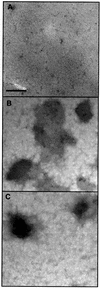Regulated phase transitions of bacterial chromatin: a non-enzymatic pathway for generic DNA protection
- PMID: 11230141
- PMCID: PMC145506
- DOI: 10.1093/emboj/20.5.1184
Regulated phase transitions of bacterial chromatin: a non-enzymatic pathway for generic DNA protection
Abstract
The enhanced stress resistance exhibited by starved bacteria represents a central facet of virulence, since nutrient depletion is regularly encountered by pathogens in their natural in vivo and ex vivo environments. Here we explore the notion that the regular stress responses, which are mediated by enzymatically catalyzed chemical transactions and promote endurance during the logarithmic growth phase, can no longer be effectively induced during starvation. We show that survival of bacteria in nutrient-depleted habitats is promoted by a novel strategy: finely tuned and fully reversible intracellular phase transitions. These non-enzymatic transactions, detected and studied in bacteria as well as in defined in vitro systems, result in DNA sequestration and generic protection within tightly packed and highly ordered assemblies. Since this physical mode of defense is uniquely independent of enzymatic activity or de novo protein synthesis, and consequently does not require energy consumption, it promotes virulence by enabling long-term bacterial endurance and enhancing antibiotic resistance in adverse habitats.
Figures




References
-
- Almiron M., Link,A.J., Furlong,D. and Kolter,R. (1992) A novel DNA-binding protein with regulatory and protective roles in starved Escherichia coli. Genes Dev., 6, 2646–2654. - PubMed
-
- Altuvia S., Almiron,M., Huisman,G., Kolter,R. and Storz,G. (1994) The dps promoter is activated by OxyR during growth and by IHF and σ S in stationary phase. Mol. Microbiol., 13, 265–272. - PubMed
-
- Chen L. and Helmann,J.D. (1995) Bacillus subtilis MrgA is a Dps(PexB) homologue: evidence for metalloregulation of an oxidative-stress gene. Mol. Microbiol., 18, 295–300. - PubMed
Publication types
MeSH terms
Substances
LinkOut - more resources
Full Text Sources
Other Literature Sources
Molecular Biology Databases

